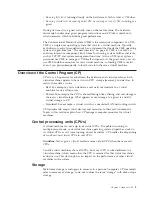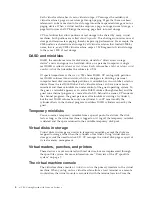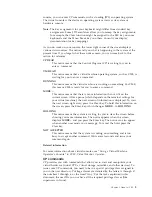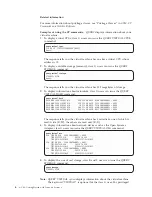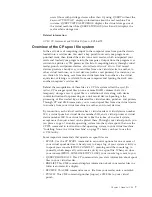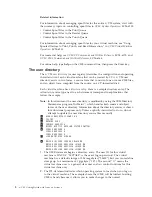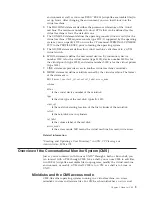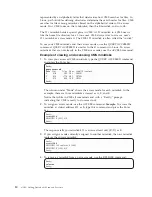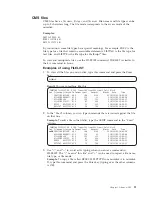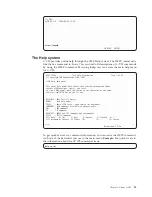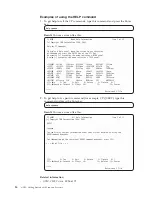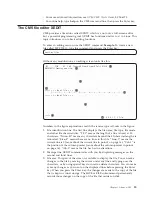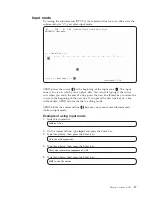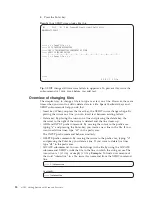
v
Running first level
: running directly on the hardware, which is what z/VM does.
v
Running second level
or
running under VM
or
running on (top of) VM
: running as a
guest.
During its time slice, a guest actually runs on the real machine. The hardware
microcode handles most guest program instructions and CP takes control only
when necessary, which maintains good performance.
The Conversational Monitor System (CMS) is the interactive component of z/VM.
CMS is a single-user operating system that runs in a virtual machine. Typically,
each directory entry (user definition) has a statement that loads the CMS operating
system at logon time (see “The user directory” on page 8). CMS is not only an
end-user interactive component, but a home for running system utilities and tasks,
such as TCP/IP and system management functions. At the z/VM level, systems
personnel use CMS to manage z/VM itself and guests. At the guest level, you can
use CMS to define resources for your virtual machine, so loading CMS is useful
even if you plan subsequently to load Linux into the same virtual machine.
Overview of the Control Program (CP)
CP acts as a hypervisor layer between the hardware and virtual machines. Each
virtual machine appears to have its own CPU, storage (memory), and devices. In
reality, these items can be
v
Real. For example, you can dedicate a real network interface to a virtual
machine for its exclusive use.
v
Shared. For example, the CPU is shared through time sharing and real storage is
shared as virtual storage. What appears as real storage to a guest is actually
virtual storage to CP.
v
Simulated. For example, a virtual switch is a simulated LAN networking switch.
CP transparently maps virtual devices and resources to their real counterparts.
Topics in this section explain how CP manages computer resources for virtual
machines.
Central processing units (CPUs)
A virtual machine can have up to 64 virtual CPUs. If capable of running in
multiprocessor mode, your virtual machine operating system dispatches work on
its virtual CPUs as if it were running on real hardware. CP handles the dispatching
of work on your virtual CPUs to real CPUs.
Guideline:
Never give a virtual machine more virtual CPUs than there are real
CPUs.
Usually virtual machines share all CPUs, but a real CPU can be dedicated to a
virtual machine, which means that the CPU is reserved for that virtual machine’s
exclusive use. This obviously has an impact on the performance of other virtual
machines in the system.
Storage
Mainframe storage is analogous to memory in a personal computer. CP commands
refer to memory as storage, so do not confuse the term “storage” with disk or tape
storage.
Chapter 1. About z/VM
3
Summary of Contents for ZVM - FOR LINUX V6 RELEASE 1
Page 1: ...z VM Getting Started with Linux on System z version 6 release 1 SC24 6194 00...
Page 2: ......
Page 3: ...z VM Getting Started with Linux on System z version 6 release 1 SC24 6194 00...
Page 10: ...viii z VM Getting Started with Linux on System z...
Page 12: ...x z VM Getting Started with Linux on System z...
Page 14: ...xii z VM Getting Started with Linux on System z...
Page 64: ...50 z VM Getting Started with Linux on System z...
Page 76: ...62 z VM Getting Started with Linux on System z...
Page 80: ...66 z VM Getting Started with Linux on System z...
Page 156: ...142 z VM Getting Started with Linux on System z...
Page 160: ...146 z VM Getting Started with Linux on System z...
Page 162: ...148 z VM Getting Started with Linux on System z...
Page 166: ...152 z VM Getting Started with Linux on System z...
Page 170: ...156 z VM Getting Started with Linux on System z...
Page 171: ......
Page 172: ...Program Number 5741 A07 Printed in USA SC24 6194 00...















